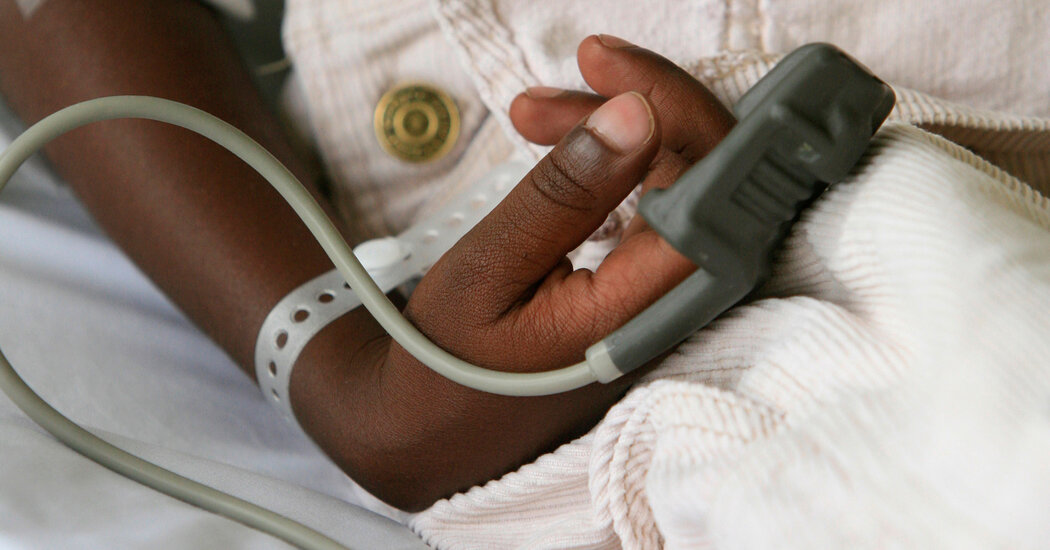The analysis, of 10,789 paired test results from 1,333 white patients and 276 Black patients hospitalized at the University of Michigan earlier this year, found that pulse oximetry overestimated oxygen levels 3.6 percent of the time in white patients, but got it wrong nearly 12 percent of the time, or more than three times more often, in Black patients.
In these patients, the pulse oximeter measures erroneously indicated the oxygen saturation level was between 92 and 96 percent, when it was actually as low as 88 percent (the results were adjusted for age, sex and cardiovascular disease).
The Coronavirus Outbreak ›
Words to Know About Testing
Confused by the terms about coronavirus testing? Let us help:
-
- Antibody: A protein produced by the immune system that can recognize and attach precisely to specific kinds of viruses, bacteria, or other invaders.
- Antibody test/serology test: A test that detects antibodies specific to the coronavirus. Antibodies begin to appear in the blood about a week after the coronavirus has infected the body. Because antibodies take so long to develop, an antibody test can’t reliably diagnose an ongoing infection. But it can identify people who have been exposed to the coronavirus in the past.
- Antigen test: This test detects bits of coronavirus proteins called antigens. Antigen tests are fast, taking as little as five minutes, but are less accurate than tests that detect genetic material from the virus.
- Coronavirus: Any virus that belongs to the Orthocoronavirinae family of viruses. The coronavirus that causes Covid-19 is known as SARS-CoV-2.
- Covid-19: The disease caused by the new coronavirus. The name is short for coronavirus disease 2019.
- Isolation and quarantine: Isolation is the separation of people who know they are sick with a contagious disease from those who are not sick. Quarantine refers to restricting the movement of people who have been exposed to a virus.
- Nasopharyngeal swab: A long, flexible stick, tipped with a soft swab, that is inserted deep into the nose to get samples from the space where the nasal cavity meets the throat. Samples for coronavirus tests can also be collected with swabs that do not go as deep into the nose — sometimes called nasal swabs — or oral or throat swabs.
- Polymerase Chain Reaction (PCR): Scientists use PCR to make millions of copies of genetic material in a sample. Tests that use PCR enable researchers to detect the coronavirus even when it is scarce.
- Viral load: The amount of virus in a person’s body. In people infected by the coronavirus, the viral load may peak before they start to show symptoms, if symptoms appear at all.
Oxygen levels below 95 percent are considered abnormal, so “a small difference in pulse oximetry value in this range of 92 to 96 percent could be the difference in deciding whether the patient is really sick or not really sick, or needs different treatment or not,” Dr. Sjoding said.
Another analysis in the study examined a multi-hospital database to compare 37,308 similar paired test results from intensive care patients who had been hospitalized at 178 medical centers in 2014 and 2015. That analysis, which was not adjusted, found similar discrepancies.
Dr. Sjoding said he and his colleagues embarked on the study after hospitals in Ann Arbor, Mich., which typically care for a predominantly white patient population, received a large influx of critically ill Covid patients from Detroit many of whom were African-American. “We started seeing some discrepancies with arterial blood gas, and we didn’t know what to make of it,” he said.
He recalled reading an article published in The Boston Review in August about racial disparities in the accuracy of pulse oximeter readings. The writer of that article, Amy Moran-Thomas, became interested in the device after buying one when her husband was sick with Covid. She dug up scientific papers published as far back as 2005 and 2007 that reported inaccuracies in pulse oximeter readings in dark-skinned individuals at low oxygen saturation levels.
Dr. Sjoding and his colleagues decided to do a study using data that had already been collected during routine inpatient care at the hospital. “What we were seeing anecdotally was exactly what we ended up showing in the final paper, that on the monitor in the patient’s room, the pulse oximeter would be reading ‘normal,’ but when we got an arterial blood gas, the saturation on the gas was low,” he said.
[ad_2]
Source link


